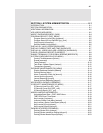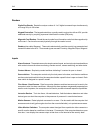
SECTION 1: INTRODUCTION 1-7
Multiple Occupancy Feature. Similar to the two-man rule except that it requires that two
keyholders enter and leave a specified zone together; refer to Section 4 for details.
File Maintenance
To perform its access control functions, the system must know the unique ID numbers of all
keyholders and the doors and times they can enter. Further, the SE 6000 maintains other
keyholder data to facilitate scheduling and reporting.
The system also needs to know details of the location of input devices and other security hardware.
File maintenance functions allow users to enter, modify, or delete employee, company, physical
connection and time information, as required.
Reporting
The SE 6000 produces a comprehensive selection of reports for display at the system terminal
or for hard-copy output from the system printer:
Alarms and Responses. A history report of alarms which occurred at a specific time and location,
and the responses taken by the security staff.
All Transactions. A report detailing all system activity. The items reported can be limited to
specific information items.
Database Changes. A report of database change activity, which includes the name of the
operator who made the changes. Note that this requires that the journaling feature be enabled.
Invalid Access Attempts. A report detailing events which were not valid accesses during specific
time periods at particular doors.
Keyholder History. A report of the last twenty uses from a particular keyholder.
Point History. A report of the last twenty events at any door or point. Designed as a quick way
to view a limited number of events. Additionally, reports can be created which provide information
about the keyholders in the system, access privilege definitions, company information, input
devices, and other subjects.
SAMPLE SYSTEM
An illustration of a basic SE 6000 system follows:


















